CACFP: What It Does and Why It Matters
What is the CACFP?
The CACFP began in 1963 as the Special Food Service Program for Children, a government-funded initiative designed to provide children from low-income families with meals when schools were not in session. Since that time, the program, now known as the Child and Adult Care Food Program, has greatly expanded to provide grants to child care centers, after school care centers, day care homes, adult day care centers, and emergency shelters serving meals and snacks. These cash reimbursements are contingent upon each center's compliance with established federal regulations. Food may be free, reduced, or paid for at a certain rate depending on each center's needs. This program is important because it provides at-risk children and adults with nutritious meals they may not have access to otherwise.
Generally, reimbursements may be provided for the following:
Centers and Day Care Homes: Up to 2 meals and 1 snack per day (for eligible children and adults)
Emergency Shelters: Up to 3 meals per day
At-risk After School Care Centers: Up to 1 meal and 1 snack per day
Generally, the program assists:
Child Care Centers & Day Care Homes: Infants and Children up to age 12
Adult Day Care Centers/Homes: Adults ages 60 or older or those who are physically or mentally impaired
After School Care Centers & Emergency Shelters: Children up to age 18
Children of Migrant Workers: Up to age 15
New guidelines on servings and meal patterns were put into place in April of 2016, and centers had until October 1, 2017 to be in compliance with these new standards. Updated servings and meal patterns by age division can be found here.
What types of food do the CACFP meal guidelines recommend?
Fruits
Most are naturally low in fat, sodium, and calories and contain no cholesterol.
Essential nutrients include potassium, dietary fiber, vitamin C, and folic acid.
Vegetables
Most are naturally low in fat and calories and contain no cholesterol.
Essential nutrients include potassium, dietary fiber, folic acid, vitamin A, and vitamin C.
Dry Beans and Peas
These provide plant protein, iron, and zinc, as well as dietary fiber, folic acid, and potassium.
They can count as either a vegetable or a protein.
Protein
Essential nutrients include protein, B vitamins, vitamin E, iron, zinc, and magnesium.
Proteins build up bones, muscles, skin, blood, and cartilage as well as enzymes, hormones, and vitamins.
Whole Grains
Whole grains retain many nutrients, such as B vitamins and vitamin E, which are stripped out of refined grains by the refining process.
Fiber in whole grains helps to lower cholesterol.
Both bran and fiber prevent spikes in blood sugar by slowing starch breakdown.
Milk (Dairy)
Essential nutrients include calcium, potassium, protein, and vitamin D.
Hydrate with Plenty of Water
Make clean drinking water accessible throughout the day.
Hydrate with Plenty of Water
Make clean drinking water accessible throughout the day.
What are the benefits of these nutrients?
Vitamin A: battles infections and keeps skin and eyes healthy
Dietary Fiber: helps reduce cholesterol
Vitamin C: aids the growth and repair of body tissues and maintains healthy gums and teeth; helps the body absorb iron
Folic Acid: aids the formation of red blood cells
Iron: carries oxygen in the blood
Zinc: aids biochemical reactions and the immune system
B Vitamins: aids in energy release, nervous system functioning, formation of red blood cells, and the building up of tissues
Magnesium: builds up bones and releases muscle energy
Calcium: builds strong bones and teeth
Vitamin D: regulates levels of phosphorus and calcium, thereby maintaining overall bone health
What does the CACFP recommend decreasing in your meal servings?
Less Salt and Sodium
High sodium intake increases the risk of high blood pressure, heart attack, and stroke.
Low Solid Fat
Solid fats are fats, such as butter, shortening, and beef fat, that are solid at room temperature.
These fats usually raise "bad" cholesterol, which increases the risk of heart disease.
Less Added Sugar
Too much added sugar, which is present in many processed foods, can result in increased blood pressure and chronic inflammation, which may result in heart disease later on in life. Tooth decay and obesity have also been linked to high sugar intake.
More information on the CACFP can be found on the USDA Food and Nutrition website at this link.
More information on healthy eating--options, tips, and benefits--can be found on the USDA Choose My Plate website at this link.












No comments:
Post a Comment